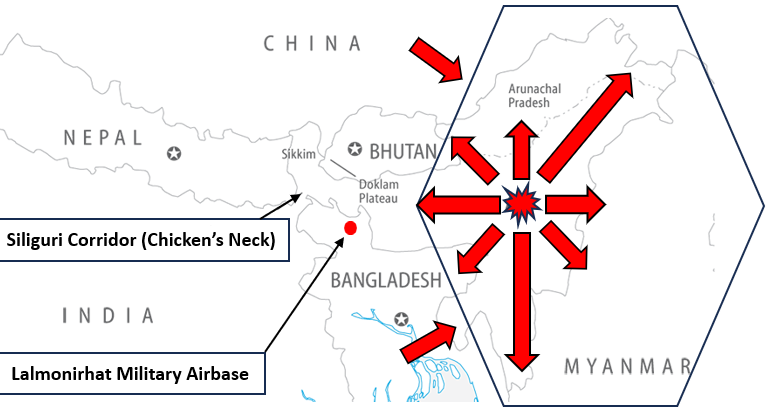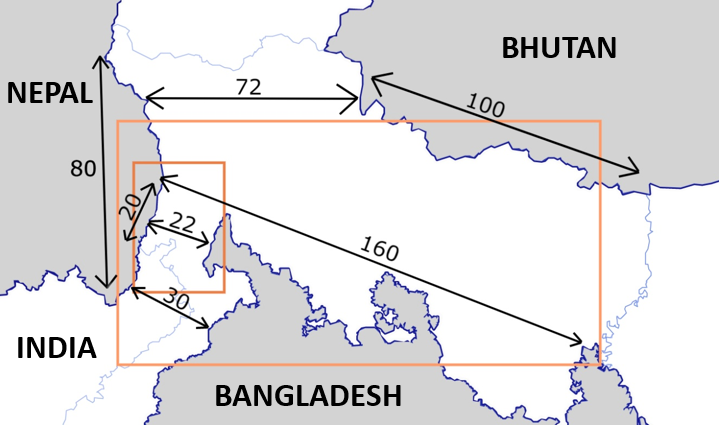Recent developments in South Asia have seen Bangladesh greenlighting for a Chinese military airbase at the Lalmonirhat Military Airbase built in 1931—a one time second biggest and largest airport in Asia. Bangladesh’s plans to allowed China to establish a military base near the narrow strip of land only 178 kilometres away, a military base that is uncomfortably close to the India’s Siliguri corridor, also known as Chicken’s Neck, a 22-kilometer-wide corridor sandwiched between Nepal and Bangladesh—it didn’t just invite investment, it also invited escalation. However, this time, Bangladesh’s decision is more than just a simple strategic move; it marks the beginning of the strategic squeeze. The threat isn’t just external, it is also partly caused by India itself.
The Geography of Vulnerability
The Siliguri Corridor is a narrow, 22-kilometer-wide strip of land in West Bengal that connects India’s northeastern states to mainland India. To the untrained eye, the corridor is just a piece of land, bordered by Nepal to the northwest, Bhutan to the north, and Bangladesh to the south. However, it is a strategic bottleneck for New Delhi, and in the event of a full-scale conflict, especially with China, the corridor’s vulnerability could effectively isolate over 51+ million people (estimate 2024) across India’s eight northeastern states from the mainland.

www.theglobalchessboard.com
(NB: The map background is adapted from the Foreign Policy Research Institute, and reworked by The Global Chessboard.)
It is this very vulnerability that shapes India’s security policies and, increasingly, its assertive stance toward bordering regions. While the 1962 Sino-Indian war had completely exposed the military preparedness of India, nevertheless, over the past decade, India has invested heavily in militarizing the corridor and strengthening border infrastructure across Arunachal Pradesh, Assam, and Sikkim. However, the rising specter of a new dual-front scenario—China from the north and Bangladesh from the south—has added a new layer of complexity to the already existing two-front conflict with Pakistan and China.
The Strategic Calculus Behind Dhaka’s Move
Bangladesh’s pivot toward China appears to be a calculated response to what Dhaka perceives as long-standing Indian overreach. As an attempt by India to move the scattered Hindus of around 8% of Bangladesh’s population—there have been murmurs in Bangladeshi policy circles about India’s covert ambitions to redraw borders, and Indian intellectuals, experts, and political strategists have been calling for it for quite some time as a strategic move to expand the Siliguri corridor. For instance, as R Jagannathan, Editorial Director of Swarajya puts
“What India should plan and campaign for — both covertly and overtly — is to move as many Hindus as possible to the divisions bordering India so that they can be strengthened and later protected. The three divisions that can be logically targeted for separation from Bangladesh are Rangpur (which is close to India’s Chicken’s Neck region and hence strategically important to us too), Sylhet, and Khulna.”
These types of narratives from well-known journalists such as R Jagannathan and others, which Delhi may have partially fostered without denouncing, will definitely fueled nationalist anxieties in Bangladesh. Thus, by strategically aligning with China, Bangladesh sends a statement that it would not be a passive viewer of India’s strategic activities. The Chinese military presence—whether advisory, logistical, or in the shape of dual-use infrastructure—acts as a deterrent not just to Indian adventurism, but also as a barrier against perceived cultural or demographic subversion.
China, for its part, sees Bangladesh as a crucial node in its Maritime Silk Road initiative. A footprint in Bangladesh would grant Beijing access to the Bay of Bengal, offer strategic depth vis-à-vis India, and provide an alternative pressure point around the Siliguri Corridor. Strategically Bangladesh’s embrace of China could effectively encircle India’s eastern, northeastern region, and the northern flanks.
India’s Dilemma: Offensive or Defensive?
India now faces a strategic quandary. The rising specter of a two new-front conflict—long a subject of security—may be inching closer to reality. With Chinese forces already entrenched in Sino-Indian border region and their infrastructural presence expanding in Nepal and Pakistan, Bangladesh’s decision has the potential to open up a volatile northeastern and southeastern flank.
New Delhi’s response so far has been one of guarded caution. Diplomatically, it has reiterated its commitment to regional stability and good neighborly relations. Militarily, however, the tone is shifting. Indian Army Chief General Manoj Pande in January 2023 visited forward posts in Sikkim and Arunachal Pradesh, signaling increased military preparedness.
Furthermore, in recent times, India has accelerated efforts to deepen ties with Bhutan—a recent “defense cooperation strengthens as high-level military talks concludes with Bhutan” in January 2025 and India’s strategic shift towards its “Neighbourhood First Policy” putting Nepal as a priority partner suggest that New Delhi is working to shore up support along its periphery before it’s too late.
North-Eastern Region of India: A Region at Risk
Perhaps the most immediate consequence of this strategic reconfiguration is the impact on India’s northeastern states. Already marked by fragile ethnic fault lines, challenging India’s sovereignty in the region by various resistance movement such as the Naga movement, insurgency movements, and underdeveloped infrastructure, the region could become the first casualty of any escalated hostilities.
The Siliguri Corridor is more than just a geographical connection; it is an economic, political, and military lifeline connecting mainland India to the northeastern states and beyond to South-East Asia, as well as connecting the northeastern states to mainland India. Any disruption to this corridor, even by non-military means such as hybrid warfare or cyber-attacks, may cause major disruptions throughout the region—a ticking time bomb ready to go off at any time if the situation worsens.
South Asia’s Strategic Fault Line
Dhaka’s initiative may be more of a signaling exercise than an open invitation to foreign military dominance or presence. However, just the perception of Chinese military assets in Bangladesh is enough to raise concerns in India’s South Block. The ramifications extend beyond bilateral difficulties and point to a broader reconfiguration of South Asia’s geopolitical architecture.
With China expanding its position in South Asia and India wrestling with the limitations of regional diplomacy, the stakes are higher than ever. The Siliguri Corridor, long regarded as a strategic weak point, is now a ground zero for a developing power contest.
In this high-stakes chessboard, Dhaka’s move is more than just a countermove to Indian assertiveness—it is a bold and risky gamble that may either secure its sovereignty or entangle it in the crosshairs of a much larger geopolitical rivalry.
About the Author: Augustine R. is an independent analyst and researcher specializing in international relations and geopolitical affairs. With a background in international relations, trade, and development, his interests span global security and economic diplomacy. He closely examines the Bangladesh-China-India-Myanmar (BCIM) strategic nexus and the evolving foreign policy dynamics within the U.S.-China-India relationship triangle. Click here to view all articles by the author.
Featured Image: Siliguri corridor with variations in measurement (Distances in kilometers). The map is available in Wikipedia. Adapted under Creative Commons Attribution-Share Alike 2.0 Generic license.

